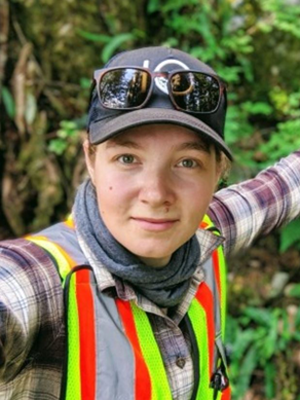Shedding Light on Forest Fires
Krystal Stone

Organizations evolve when employees see a gap or opportunity and take initiative. Krystal Stone, a CER summer student working in Environmental Protection did just that. She developed a weekly internal fire report for the CER, called the Fire Flyer, to raise awareness of wildfire status, air quality, and traffic advisories near CER-regulated energy projects from British Columbia across to Quebec.
The impacts of forest fires pose real and potentially dangerous risks to CER inspectors and Indigenous monitors who work in the field keeping pipelines safe. The historic heatwave across Canada in June and the wildfires that followed made reporting on current conditions near inspection sites critical. Krystal was tasked by her leader to find a solution.
Krystal is completing her Bachelor of Science in Forest Sciences at the University of British Columbia’s Faculty of Forestry. She is a member of the Tree Ring Lab directed by Dr. Lori Daniels, who is one of Canada’s leading fire ecologists. Krystal’s educational background is rooted in dendrochronology – a field of research that uses the information stored in tree rings to reconstruct historic climates, and even track human land use through the examination of fire scars.
“Wildfires are a healthy and a natural part of our ecosystems; they make way for new life, they mitigate the spread of pathogens and infestations, and they are even required for the propagation of some species. But since we’ve been suppressing fires so effectively for the last fifty-or-more years, we’ve let natural fuel loads grow exponentially in our forests. This has resulted in the rise of ‘megafires,’ which are extremely high-intensity forest fires that can burn hundreds of thousands of hectares in a season,” according to Krystal.
B.C experienced the Elephant Hill Megafire in 2017, which burned more than 200,000 hectares of forest in central B.C. over the course of three months. This year, the Village of Lytton burned down in a matter of hours after two consecutive days of record-breaking temperatures reaching 49.6°C, the hottest temperature ever recorded in Canada. Most of the town was on fire within 15 minutes of the ignition event, which is still under investigation.
Krystal’s goal is to raise awareness and understanding of contributing factors and safety practices related to wildfires.
“I’ve had great support from CER colleagues – they’ve been so incredibly helpful in sharing whatever resources they use in their communities to help compile the ‘Fire Flyer’. The report summarizes information from a number of external resources to provide an easy, digestible way for the CER to be prepared and knowledgeable about forest fires,” said Krystal.
On her work at the CER generally, Krystal is excited to share with her somewhat ‘skeptical’ friends about the role that CER plays in environmental protection surrounding oil and gas projects.
“Before I came to the CER I had no idea of the recent changes that had happened in regulation. I am really excited to be a part of something like this, to work with Indigenous communities to ensure these projects are done safely and in consultation with the communities they directly affect.”
“Ultimately, I believe everybody wants the same thing – even industry. I think the most important thing is we need to remember that we’re all people, we’re not just our jobs. Once we do that, we can form the relationships that are necessary to work together,” says Krystal.
At the end of August Krystal returns to her studies but hopes to return next year for another summer term.
- Date modified:
